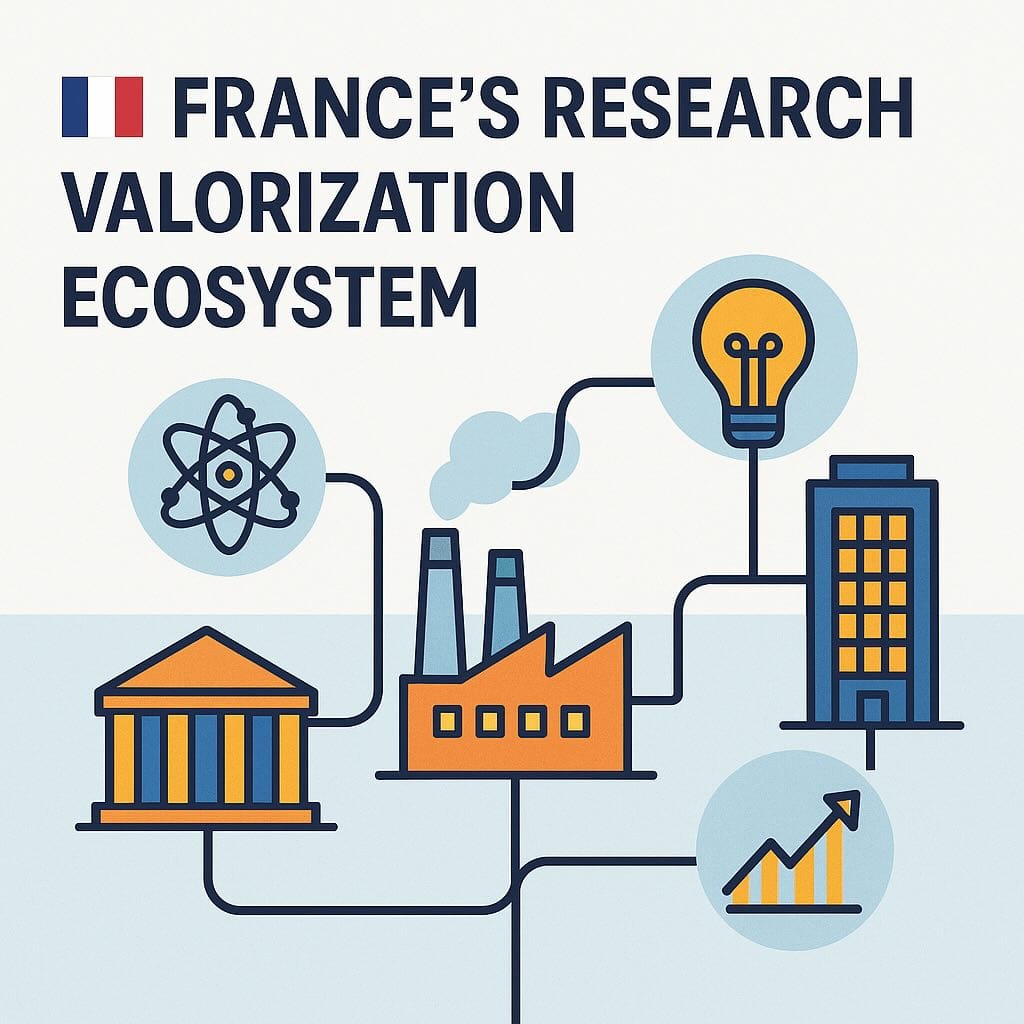France’s Research Valorization Ecosystem: A Comprehensive Guide for International Stakeholders

🇫🇷 France has built one of Europe’s most comprehensive research valorization ecosystems—combining public investment, regional coordination, and deeptech ambition. Discover how this unique model turns science into societal impact.
Introduction
France has built one of the most comprehensive and diversified research valorization ecosystems in Europe. Rooted in a strong academic tradition and underpinned by a national commitment to innovation, the French approach to valorization reflects a broad understanding of how public research can contribute to society. It encompasses not only economic and industrial outcomes but also social, cultural, and policy impacts. This document provides a detailed and narrative explanation of how this ecosystem has evolved, how it is structured today, and what makes it particularly effective and distinctive. It is designed for international stakeholders seeking to understand or engage with French research institutions, public innovation frameworks, or academic-industrial collaborations.
1. Legal Foundations and Philosophical Underpinnings
At the heart of France’s research valorization system lies the Code de la recherche (Research Code), which clearly defines four core missions of public research:
- The generation of new knowledge through scientific investigation;
- The promotion and dissemination of scientific, technical, and industrial culture;
- The enhancement of the French language as a medium for scientific thought;
- The transformation of research outputs into benefits for society—economic, social, and cultural.
What sets France apart is its broad, inclusive definition of valorization. It is not limited to patents or business creation. Rather, it reflects the State’s ambition that research should have a lasting and positive effect on all aspects of societal development—supporting evidence-based policymaking, improving public health, stimulating new industries, fostering sustainability, and building an informed citizenry.
This philosophy is embedded in the missions assigned to public researchers: beyond conducting science, they are expected to actively participate in knowledge transfer, technology diffusion, and public engagement. This is not just encouraged—it is mandated by law.
2. A History of Reform and Investment: Building the Ecosystem Over 25 Years
France’s research valorization framework has been carefully constructed over more than two decades through a combination of strategic investment, legislative reform, and cultural change. The evolution can be grouped into three major phases:
- The Pioneering Phase (1999–2009): Sparked by the 1999 "Allègre Law," this period marked the beginning of formal support for researcher entrepreneurship. It legalized and facilitated the participation of public scientists in private ventures and established the first public incubators. This foundational step set the tone for a gradual alignment of academia with innovation objectives.
- The Structuring Phase (2010–2020): With the launch of the Programmes d’Investissements d’Avenir (PIA) or "Investments for the Future" programs, France entered a new phase of proactive investment in research translation. Key national structures were created or consolidated:
- SATTs (Technology Transfer Acceleration Companies) to handle IP maturation and licensing;
- Carnot Institutes to institutionalize research partnerships;
- IRT and ITEs to anchor applied collaborative R&D in strategic sectors;
- Labex, IHUs, and thematic clusters to fund excellence in research and innovation capacity.
- The Territorial Coordination Phase (2021–present): Through the France 2030 plan, the State prioritized regional alignment and thematic focus. It launched the Innovation University Hubs (PUI) to unify innovation actors within regional ecosystems and doubled down on support for deeptech start-ups. This phase reflects a maturing system now focused on coherence, scale-up, and integration.
3. The Structural Landscape: Institutions and Interfaces
France’s ecosystem is both dense and multi-layered, with each type of actor serving a specific function while working in synergy with others.
3.1 SATTs – The Backbone of IP Valorization
The 13 SATTs, created under the PIA, are regionally anchored private companies co-owned by public research institutions and Bpifrance. Their primary missions include:
- Detecting and evaluating inventions within public labs;
- Funding and managing the technology maturation phase;
- Filing and protecting intellectual property rights;
- Licensing technologies or launching start-ups.
With over €600 million invested in projects and more than 850 start-ups created, the SATTs have proven to be a vital bridge between science and market. Their governance model—blending academic oversight with business logic—has been cited as a best practice by international observers.
3.2 OTTs – Specialized Transfer Offices Embedded in National Research Institutions
Major national research organizations operate their own Organismes de Transfert de Technologie (OTTs), ensuring that domain-specific expertise guides the commercialization process:
- CNRS Innovation manages a portfolio of 5,000+ patents;
- Inserm Transfert focuses on medical technologies and translational health;
- CEA has produced over 220 spin-offs and invests in deeptech ventures through its own fund.
These offices benefit from proximity to researchers and a long-term strategy aligned with institutional missions. Their role is essential for managing high-value IP and negotiating complex industrial partnerships.
3.3 PUIs – Regional Innovation Orchestrators
The Pôles Universitaires d’Innovation (PUIs), formalized under France 2030, are networks of universities, engineering schools, incubators, SATTs or OTTs, and regional innovation bodies. Each PUI is led by a university and aims to:
- Offer a single, visible point of contact for innovation actors on its territory;
- Harmonize valorization services and resources;
- Define a strategic roadmap aligned with local economic priorities.
By late 2024, 29 PUIs were operating across France, demonstrating strong buy-in and coordination among academic institutions.
3.4 Complementary Actors: Incubators, Clusters, and Carnot Institutes
- Allègre Incubators (19): Public entities that support the early-stage development of start-ups emerging from public research.
- Competitiveness Clusters (Pôles de Compétitivité) (55): Thematic regional networks fostering public-private R&D collaboration.
- Carnot Institutes (39): Recognized centers of excellence for industrial collaboration, responsible for over half of all academic-industry R&D contracts in France.
- IRT and ITEs: Applied research centers with shared governance between academia and industry in fields such as energy, mobility, and digital technology.
4. Pathways of Valorization: From Invention to Impact
Research valorization in France is not a linear or one-size-fits-all process. Instead, it is deliberately designed as a flexible, adaptive pathway that accommodates the specific characteristics of each scientific result, the ambitions of the researchers involved, and the economic or societal needs it may address. This pluralism allows a variety of actors to contribute to the innovation process and ensures that research outputs are matched with the most suitable mechanisms for their development and exploitation.
4.1 Licensing: Monetizing Intellectual Property
Licensing is the most established and widespread modality of valorization. It involves granting usage rights over protected intellectual property—most commonly patents, software, and know-how—to external industrial partners. This approach is particularly effective for mature, high-potential inventions ready for integration into existing product lines or industrial processes.
French public research institutions, supported by SATTs or internal technology transfer offices (OTT), conduct due diligence, secure IP protection, and negotiate licensing terms. Revenues are typically shared between the institution and the inventors, incentivizing engagement. Licensing deals are most common in pharmaceuticals, biotech, materials science, and digital technologies.
4.2 Start-up Creation: Catalyzing Entrepreneurial Innovation
Start-up creation is a preferred pathway for innovations that promise disruptive potential but require dedicated development to reach market readiness. These ventures, often referred to as deeptech start-ups, emerge from research outputs that may still be in early TRL (Technology Readiness Level) stages. They are frequently based on patented inventions, software, algorithms, or unique experimental methods.
Researchers may choose to become founders or co-founders, often supported by:
- SATTs, which provide early-stage investment and business structuring;
- Public incubators and Allègre Incubators offering tailored support;
- Bpifrance and France 2030 programs such as i-Lab, i-PhD, and French Tech grants.
These start-ups contribute to job creation, attract venture capital, and foster high-value innovation ecosystems in regions across France.
4.3 Collaborative Research Contracts: Building Long-Term Partnerships
Collaboration between public laboratories and private companies is a cornerstone of France’s valorization landscape. These partnerships take various contractual forms, including:
- CIFRE PhD agreements, which fund doctoral students working in companies on academic research topics;
- LabComs (Laboratoires Communs), co-funded by the National Research Agency (ANR), creating shared research environments between academia and industry;
- Carnot Institute partnerships, which combine excellence in research with long-term industrial relevance.
These contracts allow shared risk and reward, accelerate the transfer of knowledge, and ensure industrial applicability from the early stages of research. They are particularly effective in sectors like automotive, aerospace, agriculture, and energy.
4.4 Service Agreements and Expert Contributions
In many cases, valorization takes the form of scientific services, where expertise, data, or technical equipment is made available to external partners. This includes:
- Clinical trials and biomedical testing for pharmaceutical companies;
- Analytical services and material characterization in engineering;
- Expert consulting in economics, social sciences, and public policy.
These contracts generate revenue for public institutions, foster real-world impact, and often serve as a first step toward deeper partnerships.
This broad spectrum of valorization pathways empowers French researchers to tailor their strategy according to the maturity and nature of their innovation. Whether aiming for rapid commercial uptake, long-term industrial integration, or societal transformation, they benefit from a flexible and supportive environment. The diversity of mechanisms also ensures inclusivity across disciplines, from physics and biotechnology to social sciences and digital humanities, reinforcing France’s position as a leading hub for impactful public research.
5. Policy Instruments and Financial Incentives
France’s valorization ecosystem is underpinned by a wide array of robust public funding schemes and fiscal mechanisms designed to encourage the translation of scientific research into innovation. These instruments are aimed at lowering the risks typically associated with early-stage research commercialization, supporting entrepreneurship, and fostering fruitful collaborations between academia and industry.
5.1 Public Funding: France 2030 and Beyond
Public funding remains a cornerstone of the French strategy to accelerate research valorization. The France 2030 plan, launched in 2021, allocated more than €500 million specifically to support the maturation and pre-maturation of research results. This funding strengthens the ability of research teams to transition from lab-scale proof-of-concept to commercially viable technologies.
Among the flagship instruments financed under France 2030:
- i-Lab and i-PhD competitions: These national contests reward the most promising entrepreneurial projects led by researchers and doctoral candidates. Beyond financial support, they offer mentoring, visibility, and integration into the national innovation ecosystem.
- French Tech Emergence & French Tech Lab grants: These support start-ups at the very early stages of their development, particularly those based on public research outcomes. They provide both funding and structured incubation support, enabling scientific entrepreneurs to focus on product development and market validation.
- Strategic support to key structures: SATTs, Carnot Institutes, and PUIs have received significant and sustained funding to reinforce their missions of technology transfer, industrial collaboration, and territorial coordination. These actors act as critical nodes for implementing France 2030’s innovation priorities.
In addition to these instruments, specific programs target thematic areas (e.g., health, energy, digital) through programmes prioritaires de recherche (PEPR) and challenge-driven innovation initiatives.
5.2 Fiscal Incentives
To complement direct funding, France has developed an attractive and supportive fiscal environment to promote research collaboration and start-up creation. The most prominent fiscal tools include:
- CIR (Crédit d’Impôt Recherche – Research Tax Credit): One of the most generous R&D tax incentives in Europe, CIR allows companies to deduct up to 30% of eligible R&D expenditures from their corporate tax. This includes spending on public-private research contracts, salaries of R&D personnel, and IP-related costs.
- CICo (Crédit d’Impôt Collaboration de Recherche – Research Collaboration Tax Credit): Introduced in 2022, this mechanism specifically rewards companies that engage in formal research collaborations with public entities. It offers a tax credit of 50% for SMEs and 40% for larger firms, helping de-risk joint innovation projects and encourage long-term partnerships.
- JEI/JEU (Jeune Entreprise Innovante / Universitaire – Young Innovative / Academic Enterprises): These statuses are available to start-ups that meet certain criteria related to R&D intensity and academic origin. They confer substantial benefits, including exemptions from payroll taxes, corporate income tax, and local taxes for several years. The JEU status specifically supports start-ups led by recent graduates or researchers engaged in commercialization of their scientific work.
These incentives not only lower the financial barriers to innovation but also send a strong signal of governmental support for a dynamic and inclusive research-to-market pipeline.
Taken together, France’s public funding programs and fiscal instruments form a coherent and well-integrated policy framework. They aim to mobilize the entire research and innovation value chain—from idea to impact—while fostering public-private synergies and strengthening France’s role as a European leader in deeptech and knowledge-based entrepreneurship.
6. Global Performance and Outlook
France has emerged as a global leader in the field of public research valorization, combining institutional reform, strategic public investment, and an increasing cultural shift toward innovation and impact. The country’s sustained commitment over two decades is now reflected in its strong international standing and measurable results.
6.1 International Rankings and Indicators
France consistently ranks among the top-performing countries for research valorization outcomes:
- In 2023, it was ranked 3rd among OECD countries for the number of patents filed by public research institutions.
- 11% of national patent applications in France involve at least one public research or higher education institution, a clear indicator of academic engagement in innovation.
- According to the national deeptech observatory, over 60% of deeptech start-ups supported by SATTs originate from universities or grandes écoles, showing a strong entrepreneurial dynamic within academia.
These figures illustrate not only the vitality of the French innovation ecosystem but also the increasing alignment between public research and industrial competitiveness.
6.2 Benchmarking Against Global Technology Transfer Offices (TTOs)
French SATTs, though younger than many of their international counterparts, now rival and in some respects exceed the performance of globally recognized technology transfer offices. Comparative studies (e.g., by ADIT and ANR) indicate that:
- The conversion rate of inventions into start-ups among French SATTs (~2.35%) is on par with, or above, leading institutions such as Imperial College London (2.3%), University College London (2.6%), and significantly ahead of MIT (0.6%) and Stanford (1.1%).
- Licensing revenue and IP portfolios managed by entities like CNRS Innovation and Inserm Transfert are comparable to those of their peers in the UK, Switzerland, and Germany.
Moreover, SATTs have demonstrated an ability to operate at scale across diverse scientific domains, from biomedicine and engineering to AI and quantum technologies, ensuring a widespread and inclusive impact across sectors.
6.3 Toward European Leadership and Strategic Sovereignty
These performances should be viewed not only as a national success, but as part of a broader European ambition. France’s valorization model contributes directly to the strategic objective of strengthening European technological sovereignty. It complements other EU efforts such as Horizon Europe, the European Innovation Council (EIC), and deeptech scale-up initiatives.
France’s ability to generate high-impact spin-offs, secure industrial partnerships, and mobilize territorial ecosystems makes it a natural partner for transnational collaboration. From joint patent portfolios to shared incubator programs and cross-border lab consortia, France actively positions its ecosystem as open to cooperation with European and global actors—while maintaining a clear focus on strategic autonomy.
6.4 Looking Ahead
As the France 2030 plan reaches maturity, emphasis will likely shift toward sustainability, long-term evaluation, and post-funding integration of successful programs. Key priorities include:
- Strengthening the link between valorization and societal missions (health, energy, climate, digital sovereignty);
- Promoting diversity of actors involved, particularly from humanities and social sciences;
- Enhancing data-driven impact assessment and international benchmarking.
The combined effect of targeted investments, institutional agility, and cultural evolution places France in a strong position to shape the future of research valorization—both at home and in concert with its European and international partners.
Conclusion: A Cohesive and Ambitious Model
France’s research valorization system represents a holistic, ambitious, and evolving approach to translating scientific excellence into real-world impact. It balances national priorities with regional dynamism, central coordination with institutional autonomy, and public support with private initiative.
By aligning structures like SATTs, OTTs, PUIs, Carnot Institutes, and regional clusters under the strategic vision of France 2030, the country offers a mature and effective model within the broader objective of strengthening European technological sovereignty.
While rooted in national priorities, France’s approach to research valorization recognizes the importance of transnational cooperation, particularly within the European Union. In an increasingly competitive global environment, sharing best practices, aligning standards, and building joint platforms for deeptech development are essential to ensure Europe’s collective capacity to innovate and lead.
France thus positions itself not only as a source of innovation, but as a proactive partner in shaping a resilient, sovereign, and interconnected European research and innovation ecosystem.
Glossary of Acronyms
- SATT: Sociétés d’Accélération du Transfert de Technologies (Technology Transfer Acceleration Companies)
- OTT: Organismes de Transfert de Technologie (Technology Transfer Offices)
- PUI: Pôles Universitaires d’Innovation (Innovation University Hubs)
- PIA: Programmes d’Investissements d’Avenir (Investments for the Future Programs)
- IRT/ITE: Instituts de Recherche Technologique / Instituts pour la Transition Énergétique (Technological / Energy Transition Institutes)
- CIR: Crédit d’Impôt Recherche (R&D Tax Credit)
- CICo: Crédit d’Impôt Collaboration (Collaboration R&D Tax Credit)
- JEI/JEU: Jeunes Entreprises Innovantes / Universitaires (Young Innovative / Academic Enterprises)
- i-Lab / i-PhD: National innovation and entrepreneurship competitions
s


